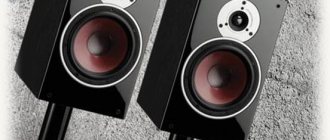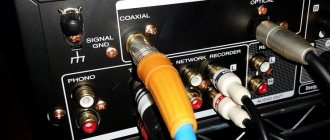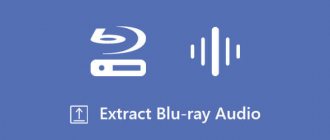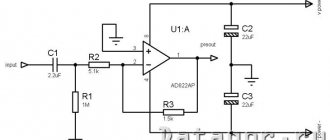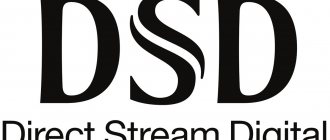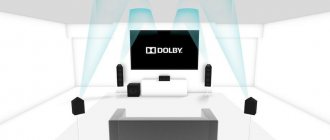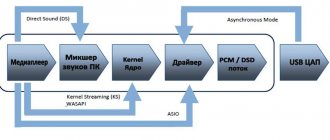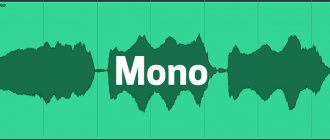DTS-HD has forever changed the way we think about digital audio and sound quality. Now everyone can experience what a truly ideal sound is
Ideas about the creation and most successful implementation of an ideal (!) multi-channel audio recording have tormented the minds of the world's best developers for quite a long time. But not everything and not always was crowned with the expected victory...
For example, the SACD (Super Audio CD) format could not become as successful as possible, despite its obvious advantages. And the reasons for this are different - a small active catalog, insufficient demand in the market... But today we will refrain from going into details on this topic (we’d better save it for next time), since over the past few years the attention of experts and lovers of the highest quality digital sound has been attracted by the DTS-HD format , as well as the concept of Blu-ray Audio in general. This is, perhaps, worth talking about in more detail.
The battle for supremacy surrounded by sound in every detail
As home theater systems have evolved, new surround sound formats have emerged that add detail and realism to evening viewing. Let's go back to basics and look at the two most popular of them - DTS and Dolby Digital.
Both DTS and Dolby Digital are audio compression technologies that allow movie producers to record multi-channel audio that can be played back in theaters or on home systems. Both provide amazing sound quality. What is the difference between them and which one is better?
The devil, as always, is in the details. Or, more precisely, in the audio encoding methods used by both technologies.
DTS encodes the signal at a higher bitrate and is considered higher quality by some experts for this reason. Others argue that Dolby Digital has superior technology, allowing it to produce higher-quality sound at lower bit rates.
Already confused? It's not that complicated: both options are widespread, and most likely you won't have to choose.
In their basic form, both DTS and Dolby Digital encode 5.1-channel audio (that is, they are designed for a typical home audio system with five speakers and one subwoofer). More advanced versions of the technologies, DTS:X and Dolby Atmos, support 7.1-channel formats, HD surround sound and overhead speakers.
DTS and Dolby Digital can be found in Blu-ray players, home theaters, game consoles, computers, set-top boxes and even smartphones. In our material you will learn how DTS and Dolby Digital differ – and why it is important.
Surround (multi-channel) sound
Sound that is split into more than two channels when played back is called multichannel. Some also call it volumetric, which is also correct.
The basic principle of this sound reproduction format, as is already clear from its name, is that each specific sound direction has its own dedicated channel with a separate independent loudspeaker, which has its own strictly spatially oriented location and direction.
Main full-range channels in surround mode
- left,
- right,
- central (may also have additional left and right),
- lateral left and right
- and, depending on the format, several rear channels.
Also, in deployed surround sound systems, additional channels can be added in each sound direction and even in the ceiling area around the perimeter of the home theater room. A separate additional improvement in any version of a multi-channel speaker system, which can significantly decorate and expand the low-frequency base, will be the use of an additional low-frequency loudspeaker - a subwoofer (its frequency range is 2-120 Hz).
What is Dolby Digital?
Dolby Digital is an audio codec developed by Dolby Labs. It creates multi-channel audio and is often referred to as the "industry standard" (mainly because Dolby Labs started working long before DTS).
The first film to use Dolby Digital was 1992's Batman Returns. Since then, Dolby has released a series of increasingly advanced codecs, including Dolby Digital Plus, which supports multi-channel HD audio and up to 7.1 channels.
The best of these is Dolby TrueHD, a lossless format that promises sound identical to studio master recordings. And finally, there is a new generation of audio technology based on the concept of objects - Dolby Atmos.
Features of DTS
The main advantage is that the audio codec can work with various acoustics - both 7.1 format and the usual stereo. This is achieved due to the fact that the audio track takes into account only the location of the object in space, and not the number of channels in the speaker system.
REFERENCE! This format allows for higher quality sound and is becoming increasingly popular. It most often features high-quality HD movies that can be downloaded on the Internet. This is why it is so important that your TV supports DTS.
Very often, users are unable to watch a downloaded movie because the audio track is encoded in a format that is not supported by the device. What to do in this case?
What is DTS?
DTS (originally called Digital Theater Systems) was founded in 1993 to compete with Dolby Labs for supremacy in multichannel audio. Its finest hour came when Steven Spielberg chose DTS for his blockbuster Jurassic Park.
In 1996, DTS technology began to penetrate the consumer equipment market. Despite the company's lower profile compared to its main competitor, many purists believed that DTS had superior audio quality due to the audio being encoded at a higher bitrate.
Like Dolby Digital, DTS has since released a number of even more advanced surround sound formats, including DTS-HD High Resolution, which supports up to 7.1 channels, the lossless format DTS-HD Master Audio, and DTS:X, which competes with Dolby Atmos.
History [edit | edit code]
One of Digital Theater System's original investors was director Steven Spielberg, who believed that, until the founding of the company, audio formats were outdated and, as a result, suboptimal for use in projects where sound quality was of paramount importance [1]. Work on the format began in 1991, 4 years after Dolby Laboratories began work on its new Dolby Digital codec.
The most widely used format is DTS 5.1, which is similar to Dolby Digital and encodes six sound channels (5.1): three front channels (full range), 2 surround channels (80-20000), and they also contain a track up to 80hz for the subwoofer (LFE, English. low frequency effects; low frequency emitter).
The encoder and decoder support numerous channel combinations: stereo, four-channel, four-channel and LFE - such soundtracks are commercially released on DVD, CD and Laserdisc. When using DTS in movie theaters, the sound recorded on a CD is synchronized with the image using time stamps printed on the film print in the space between the Dolby SR analog optical soundtrack and the image [2]. Varieties of the DTS format intended for cinemas and for household devices differ greatly in encoding algorithms and compression levels [1].
DTS-ES is a variation of the DTS format that supports up to 7 primary channels and one low-frequency channel (LFE).
Dolby Digital and SDDS formats remain alternatives (competitors) to the DTS format when encoding multichannel audio. DVDs and home theaters only use DTS and Dolby Digital.
The DTS format was first used in 1993 to encode the sound of Steven Spielberg's film Jurassic Park [1]. Dolby Digital was first used in 1992 (the year before) to encode the audio for the theatrical version of Batman Returns. In 1995, A Clear and Present Danger was released on Laserdisc; The audio on the disc was encoded in Dolby Digital, marking the first time Dolby Digital was used for home viewing. In 1997, the film Jurassic Park was released on Laserdisc containing DTS audio—the first time DTS was used for home viewing.
What is the difference between DTS and Dolby Digital?
Both Dolby Digital and DTS provide an amazing surround sound experience - but the way they create it is different.
The main differences are in the degree of compression and bitrate values. Dolby Digital compresses 5.1-channel digital audio to 640 kilobits per second for Blu-ray Discs and 448 kilobits per second for DVDs.
DTS has less compression and higher bit rates - up to 1.5 Mbps for Blu-ray discs and up to 768 kbps for DVDs.
The difference in compression becomes even greater for HD formats. Dolby Digital Plus supports up to 1.7 Mbps, and DTS-HD High Resolution supports up to 6 Mbps. In theory, lower levels of encoding compression provide greater detail in the result, making the audio track appear more like what was intended.
So, is the issue resolved? Not really. Dolby believes that its codecs are more efficient than DTS's and are therefore capable of producing equally or better quality audio using lower bitrates.
Ultimately, both technologies will provide a rich home viewing experience, and the choice of soundtrack will sometimes be determined by which format is supported by the available source.
Why you should use the DTS format and how to do it at home
The need for such a mode appears when you need to play a downloaded file, where the audio track is in the DTS. Most modern TVs do not have this format, but there is no need to panic. You can easily solve the problem on your own, without any special skills or knowledge in the field of technology.
The first way is to convert the file on your computer, but this takes a very long time, even if you have an incredibly powerful processor. In addition, constantly changing files manually may not be very convenient.
That is why a special application appeared, by installing which you can get rid of the problem.
You just need to download the application to your device and install it. First of all, open the archive with the files and copy the samygodca folder. Then we insert the flash drive into the TV and use it to save the file to the TV. Now, every time you need to launch the application, you will need to go to the folder where the file is stored and click on it. After this, the download mode will appear on the screen, and then you will be returned to the folder.
This will mean that the file was decoded successfully and you can enjoy your movie or other video in DTS with excellent sound and high-quality audio track.
Now you know the features of the DTS format, why you should use it and what to do if your TV does not support it. With this format, viewing files on TV will become even more enjoyable and interesting.
As we know, Samsung does not support the DTS Audio codec on its TVs starting with the 2022 model range. Models produced before 2022, of course, still support DTS. Many buyers ask questions when a new TV shows a movie without sound, “Why doesn’t the new Samsung TV play DTS?”, “Why is there no sound in the video?”
There is no definitive solution to this problem yet. In any case, on the developer’s website in such cases it is only suggested to select a different audio track. Let's try to figure out what can be done if you need to play multi-channel DTS audio on Samsung TV 2022 and higher, despite the lack of codec support. In addition, we will try to reveal the possible reasons and solutions for the lack of DTS support on Samsung 2022 models.
DTS:X and Dolby Atmos
These cutting-edge audio technologies are superior to traditional multi-channel audio in every way. They recreate object-based effects, such as a plane flying overhead or bullets whizzing across a room, thanks to the array of sounds produced by an advanced speaker package.
Both technologies provide complete immersion, but achieve it in different ways.
Dolby Atmos creates a “dome” of sound using speakers mounted on the ceiling. If you're not keen on drilling holes in it, there are a few simplified options, including Dolby Atmos soundbars with upward-firing speakers that bounce the sound off the ceiling to create much the same effect, and add-ons for traditional upward-firing speakers.
LG's 2022, 2022 and 2022 OLED TVs also support Atmos, and the Panasonic GZ2000 4K OLED TV features built-in upward-firing Dolby Atmos speakers at the rear.
More and more equipment manufacturers are releasing devices that support Dolby Atmos; The catalog of Blu-ray discs and streaming services with compatible content is growing, including Amazon Prime Video and Netflix. Television broadcasters are gradually joining them.
DTS:X is more flexible. It works with standard multi-channel sets and does not require additional overhead speakers. In addition, it allows you to manually adjust audio objects - for example, increasing the volume of voices in the soundtrack so that dialogue is heard better against loud effects.
Approximately 90% of home theater components are DTS:X compatible; Many manufacturers either offer firmware for existing AV receivers or release new models. There is only one drawback - less widespread content. Neither Amazon Prime Video nor Netflix currently support DTS:X.
Digital audio from A to Z
Do you sometimes get confused about the terms used to describe audio devices? We've created a short guide to help you understand them.
Basics: What is Digital Audio Recording
Because sound is constantly changing in the real world, digital recordings are always an approximation of the full range of natural sound. However, new recording technologies are continually expanding the range and accuracy of digital recording.
When an analog source, such as a live concert or musicians in a recording studio, is recorded digitally, the sound is sampled at regular intervals. The amplitude of the sound is recorded as a number, and the result is a digital recording of the analog source as a sequence of discrete numbers.
The proportion of the original analog audio captured in a digital recording depends mainly on the sample rate and bit depth (how many samples are created per second and how much information each sample contains).
Digital Audio Storage
Once a digital recording is created, it can be saved in a variety of formats. Each format solves the issue of balancing sound quality and the size of the generated file differently: for example, as practice shows, very high-quality recordings are not very suitable for small music players.
But with the proliferation of digital storage (portable devices can store many gigabytes of data), very high-quality audio is becoming a daily occurrence for millions of people.
Audio characteristics from A to Z
| 5.1 Audio 7.1 Audio Analog Audio Bit Depth Codec Compression Digital Audio Dolby Digital Dolby True HD | DSD DSEE HX DTS Digital Surround DTS Master Audio DTS:X Hi-Res Audio LDAC Low Frequency Effects (LFE) Lossless | Lossy LPCM S-Master HX SA-CD Sampling Rate SBC Subwoofer Surround Upscaling |
5.1 Sound This is a 5.1 channel surround sound system to create a cinema-like surround sound experience. Five speakers and one subwoofer are positioned around the listener, each delivering only one channel of audio in the following configuration:
- Two front channels.
- One front center channel.
- Two channels of surround sound.
- One low frequency effects (LFE) channel
The subwoofer, which is supplied with a dedicated low-frequency channel, can be placed anywhere in the room. Compared to a surround sound system without a subwoofer, a configuration with a subwoofer saves space because all low frequencies are transmitted through one channel, other speakers can be made smaller. See also 7.1 sound
7.1 Sound This is a 7.1 channel surround sound system that uses 7 speakers and one subwoofer. It is similar to a 5.1-channel sound system, but includes two additional surround back channels.
Analog Sound In analog recording, the original sound is represented by changes to a physical medium, such as magnetic tape or a vinyl record. This approach is different from digital recording.
Bit Depth The bit depth of a digital recording determines how many bits (or bits) are used to store each sample of an analog signal. The standard bit depth of CD audio is 16 bits and the sampling frequency is 44.1 kHz. This means that 44,100 samples are generated per second, each containing 16 bits of data. In general, the higher the bit depth, the better the audio quality and the larger the file size.
Hi-Res Audio, or high-resolution audio, has a bit depth of at least 24 bits with a sampling rate of 96 kHz or higher.
Codec In digital recording, the audio signal is processed by an encoder/decoder, or "codec" for short. It is a software or hardware component that "encodes" an analog audio signal into a digital format for electronic storage. When audio is played back, the codec "decodes" the digital file to produce sound.
Audio codecs use different methods of encoding an analog signal and provide certain advantages when storing and playing back audio.
Compression Digital audio recording can produce large file sizes, limiting the usefulness of digital audio; for example, a digital music player will only fit a small amount of music in this case. Therefore, most audio formats use some form of compression, removing some audio data to reduce the size of the resulting file.
The way data is compressed and extracted during playback affects the resulting sound. File formats in which some of the data is lost are called lossy formats. Formats that preserve all audio data or allow it to be completely restored during playback are called lossless formats.
Digital Audio Unlike analogue, digital recording converts sound into a series of numbers that can be stored electronically (such as on a CD or hard drive) and then converted into sound when played back. A popular digital format is MP3.
Dolby Digital The standard lossy audio format for DVDs and the base audio encoding format for Blu-ray Discs. Although it is a lossy format, it is good enough for cinema. Compared to DTS Digital Surround, the sound quality is lower, but the higher compression ratio allows for smaller files, so Dolby Digital is more widely used.
Dolby True HD A lossless audio compression format similar to DTS Master Audio. Both formats are used for Blu-ray Discs.
DSD Direct Stream Digital (DSD) is a digital recording method with a very high sampling rate; it is much higher in quality than high-resolution audio formats, and in the case of audio CDs it is 64 to 128 times superior in quality. Some recording engineers believe that this digital format is as close as possible to the original analog source. Some Sony Hi-Res Audio models also support DSD.
DSEE HX DSEE HX is a unique digital audio enhancement technology developed by Sony. When playing digital audio in a compressed format, DSEE HX technology reconstructs lost high frequencies in real time, delivering audio quality comparable to high-definition audio. Any audio played on a DSEE HX-enabled device is optimized so it feels like you're in a recording studio or at a concert.
DTS Digital Surround The standard lossy audio format for DVDs and the base format for audio encoding on Blu-ray Discs. DTS Digital Surround provides higher quality than Dolby Digital, but is less common because file sizes are much larger.
DTS Master Audio A lossless audio compression format similar to Dolby True HD. Both formats are used for Blu-ray Discs.
DTS:X DTS:X is a surround sound audio format that rivals Dolby Atmos in terms of sound quality. This is the standard for spatial audio to create a completely immersive experience. With the help of additional height channels of multi-channel audio, an expanded sound field is created, so that the viewer is completely immersed in what is happening.
Hi-Res Audio, or high-resolution audio High-resolution digital audio formats with a sampling rate of 96 kHz / 24 bits and higher. This technology provides much higher sound quality than CDs and MP3 files (standard CD format is 44.1 kHz/16 bit).
If a Sony product bears the Hi-Res Audio logo, it means that the product is designed specifically to optimize high-resolution audio quality during playback. You can set up a complete high-definition audio experience on any Sony device, from portable music players to headphones, speakers and home theater systems.
Learn more about High-Resolution Audio
LDAC LDAC is a Sony audio codec that allows you to listen to high-quality audio over a wireless Bluetooth connection.
When transmitting audio over a Bluetooth connection, the standard Bluetooth SBC codec is typically used, which may result in loss of quality. LDAC allows 3 times more data to be transferred than the SBC codec, providing higher quality audio when streaming over Bluetooth.
Low Frequency Effects (LFE) Channel The Low Frequency Effects (LFE) channel is a separate audio channel specifically for low frequencies in the range of 3 to 120 Hz (such as booming sound effects in movies). In surround sound systems, this channel is usually fed to the subwoofer.
Lossless Lossless formats allow you to store digital audio without losing the original data, or to completely restore the original data during playback. Lossless formats include:
- DSD (DFF)
- DSD (DSF)
- WAV
- AIFF
- FLAC
- ALAC
Lossy Lossy formats remove some information from the original digital recording to save space while attempting to preserve as much of the original sound quality as possible during playback. Each of these formats represents a compromise between compression (to save space) and data storage (to preserve sound quality).
Lossy formats include:
- A.A.C.
- Dolby Digital
- DTS Digital Surround
- MP3
LPCM Pulse code modulation (LPCM) is the basis of digital audio recording. The analog signal is sampled at regular intervals and its amplitude is recorded as a point on a digital scale. Since the data is not processed or compressed, the sound quality is comparable to professional studio recordings, but this recording method produces very large files. Therefore, LPCM is not suitable for everyday use.
The sampling rate determines the accuracy of the original digital stream.
S-Master HX Sony digital amplification technology designed specifically for high-resolution audio formats; it serves to reduce distortion and noise over wider frequency ranges. Because S-Master technology amplifies digital signals directly (without converting them to analog signals first), all the purity of the original signal is preserved.
SA-CD Super Audio CD is a format developed by Sony to record DSD audio with a dynamic range exceeding that of Audio CD. The dynamic range of a standard CD is 96 dB, and the range of an SA-CD is 120 dB. The SA-CD format has a sampling rate of 2.8 MHz, which is 64 times higher than a standard CD.
Unlike a regular CD, SA-CD supports 5.1-channel surround sound as well as 2-channel (stereo) sound. SA-CD audio is encrypted for copy protection, meaning it can be played over analog, HDMI or i-Link cables, but not over optical or coaxial cables.
Sampling Rate When recording an analog source in digital format, the sampling rate is the time interval between samples. The higher it is, the less data is omitted. For example, the audio sampling rate on CDs is 44.1 kHz, which means 44,100 samples are generated every second.
Generally, the higher the sampling rate, the better the recording quality. The high-resolution audio sampling rate is 96 kHz and the bit depth is at least 24 bits.
SBC Standard audio codec for digital audio streaming over Bluetooth. Since the SBC codec is designed to prioritize connection stability (i.e. efficient use of wireless channel bandwidth), it is not well suited for high-quality audio transmission. Sony's LDAC codec transmits three times more data than SBC, enabling high-quality Bluetooth audio playback.
Subwoofer In a 5.1-channel or 7.1-channel surround sound system, a subwoofer is a speaker that produces only low-frequency sounds or a dedicated low-frequency effects channel. Since it is difficult to determine the source of low frequencies by ear, the subwoofer can be placed anywhere in the room.
Since all the low frequencies are sent to the subwoofer, the size of the other speakers can be smaller, so the overall system becomes more compact and takes up less space.
Surround Sound 5.1-channel and 7.1-channel surround sound systems are designed to reproduce channels of sound individually through separate speakers positioned around the listener; this allows you to create a more realistic sound. The second digit in the designation of multi-channel systems (in this case, the number “1”) indicates the number of low-frequency channels; in this case, one subwoofer is used as an additional low-frequency speaker.
Upscaling When playing digital audio in lossy formats, it is sometimes possible to fill in some of the "gaps" in the original recording by mathematically extrapolating from the original data. This process is called "quality enhancement" and can significantly improve the quality of some recordings.
The unique DSEE HX algorithm, developed by Sony engineers, enhances the quality of lower-quality source recordings, bringing the sound closer to the quality of high-resolution audio formats.
